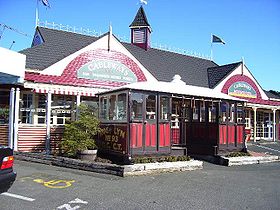- Dunedin cable tramway system
-
The Dunedin cable tramway system was a group of cable tramway lines in the New Zealand city of Dunedin. It is significant as Dunedin was the second city in the world to adopt the cable car (the first being San Francisco).
Contents
History
The first Dunedin cable car line opened in 1881, the engineer responsible being George Smith Duncan. For this system he introduced the pull curve and the slot brake; the former was a way to pull cars through a curve, since Dunedin's curves were too steep to allow coasting, while the latter forced a wedge down into the cable slot to stop the tram, which was deemed necessary after the line had a runaway tram some two months after it opened.
The last line closed on 2 March 1957.
Lines
Roslyn and Kaikorai
Dunedin's first cable car served Roslyn (although initially only going as far as the town belt), covering a distance of 1.4 miles, opening on February 6, 1881. The line went up Rattray Street, with the world's first pull curve in front of St Joseph's Cathedral. It then cut through the Town Belt in Belleknowes (where the cutting is still generally visible) past the Beverly-Begg Observatory to climb the full length of Ross Street and part of Belgrave Crescent, then descend through a cutting to the valley near Frasers Road.
The last cable car ran on this line on on October 25, 1951[1]
The western section beyond the cutting was too steep for a road link, so, when the cable cars ceased, the portion near Belgrave Crescent was redeveloped as a short street serving several houses while retaining the pedestrian walkway through to Delta Street. Trolleybuses replaced the service as far as Belgrave Crescent, using City Road instead of the straight steep cutting through the Town Belt.
Stuart Street
Travelling a distance of 1.2 miles, the Stuart Street line opened on October 6, 1900, running largely parallel to the Roslyn line. The track went up Stuart Street from The Octagon, turned half-right at York Place into what was then called Albert Street, continued on past the end of that street through a short section of Town Belt, past Otago Boys' High School, across the bottom of Littlebourne Crescent and up to Highgate at School Street, then dropped down to Kaikorai just before Nairn Street, where a turntable in the road turned cars through 90° and sent them south-west into their shed. The route was eventually turned into a four-lane highway, cutting Littlebourne Crescent off from Littlebourne Road, going under a new bridge and undergoing considerable widening on the Kaikorai side, restricting access to Ann Street and Oates Street. It closed on July 31, 1947.
Mornington
Opening on March 23, 1883, the Mornington line travelled one mile up High Street to Mornington. Cable Car House (now a plumbing business) is still clearly marked in the shopping area, having had little external changes since the line closed. The Mornington line was the last to close, on March 2, 1957, leaving San Francisco with the only operational cable car system in the world.
Maryhill Extension
The Maryhill Extension exited from the back of the Mornington cable car house, following Glenpark Avenue for 0.5 miles. The line was perfectly straight, and was sometimes referred to as The Big Dipper, similar to a roller coaster, going steeply down one side of the valley and then up the other side. It opened on March 18, 1885 and closed on October 29, 1955.
Elgin Road Extension
The Elgin Road Extension also left the Mornington cable car house, going up Mailer Street and then following Elgin Road for a total of 0.9 miles. It opened on October 6, 1906, and closed only four years later, on January 22, 1910. In contrast to Dunedin's other cable car lines, there was very little gradient on this line, perhaps explaining its early closure.
See also
- San Francisco cable car system
- Citibus (New Zealand) (successor to Dunedin's cable car service)
Sources
- The most extensive information including pictures and detailed history
- Kaikorai Cable Cars
- Dunedin's Trams Dunedin City Council
- 1881 Dunedin Cable Car on 1985 35c stamp
References
- ^ The Evening Star, 26 October 1951
External links
Categories:- Cable car railways
- Public transport in New Zealand
- Rail transport in New Zealand
- Tram transport in New Zealand
- Transport in Dunedin
- History of Dunedin
Wikimedia Foundation. 2010.

